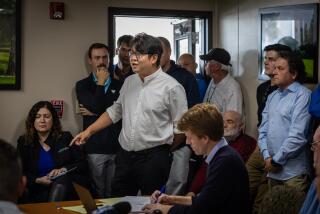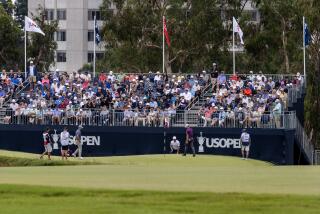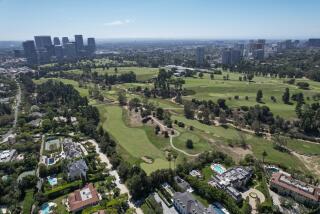Metal Headed for the Scrap Heap
- Share via
Their introduction caused a heated debate. But three years after non-metal spikes became a widespread requirement, the subject barely raises an eyebrow among today’s golf community.
Non-metal spikes have become the norm on golf courses, most of which have banned metal spikes. At first resisted, they not only caught on, but have left metal spikes on the road toward extinction.
“It’s pretty much accepted as the way it is now,” said Rob Ford, Director of Golf at Pelican Hill Golf Club in Newport Coast, which requires non-metal spikes. “At first, people didn’t like it, but after the first initial adjustment period it’s been a pretty easy transition.”
Plastic alternatives to metal spikes first hit the market in 1992. After a few years of limited use and lots of research about their effect on putting surfaces, they became mandatory at many country clubs and high-end public courses beginning in 1996.
These days, even if you find a course that allows metal spikes, wearing them transgresses the bounds of political correctness.
“I used to think it was cool to walk around in spikes and make that clinking noise,” said Greg Flores, spokesman for the Southern California PGA. “Now if you hear that noise, you would stare at the guy and be like ‘What are you thinking?’ ”
At first, golfers were reluctant to comply. Many course operators recall complaints about the non-metal policies despite their offer to change the spikes at nominal fees.
Ron Benedict, course superintendent at Newport Beach Country Club, held a soft-spike tournament to encourage golfers to give non-metal spikes a try. Shortly after that, the club voted on the ban of metal spikes.
“The members didn’t want to make the change,” Benedict said. “But once we had the event and physically saw the difference, it was an easy decision.”
The biggest difference came in a 10-foot circle around the hole.
“That’s where everybody eventually lines up a putt,” Benedict said. “That area can get pretty bumpy with [damage done by] metal spikes, especially in the afternoon.”
Since most golfers like smooth greens and rule 16-1 of the Rules of Golf prohibits the repair of spike marks prior to putting, the majority appear in favor of the non-metal spikes.
But Benedict said there are reasons other than smooth greens to favor non-metal spikes too.
“Metal spikes are pretty abusive to the grass,” he said “It’s enough that we are cutting the tops off the grass every day, then we have people pushing the grass into the ground with those spikes. It’s not good for the green.”
Still, there are those who refuse to change. Hank Wilcox, 67, of Garden Grove, is one of them.
He has been playing golf almost 50 years and said he has always worn metal spikes and doesn’t see the need to change. He seeks out courses such as Willowick and River View in Santa Ana that allow metal spikes.
“But sometimes I play at courses that don’t allow them,” Wilcox said softly. “I just sneak on.”
Course operators may not know about spike rebels such as Wilcox, but other golfers sure do.
“I was out at Coyote Hills [which doesn’t allow metal spikes] putting one day,” said Flores, the SCPGA spokesman. “And somebody had been there with metal spikes. You could see every step he took, and every place he stood to putt. It was amazing.”
Steve Hart, general manager at River View, said he has considered instituting a policy prohibiting metal spikes but said customers such as Wilcox prevent him from doing so.
“We have a big senior contingent that doesn’t want to change their way,” Hart said. “But it’s not a real big issue for us.
Some golfers don’t have a say in the matter.
Antonio Gomez, 22, of Santa Ana, was playing at River View this week in recently purchased shoes that had plastic spikes. His reason?
“The store where I bought them didn’t have any shoes with metal spikes,” he said. “I didn’t have much of a choice.”
At the Roger Dunn Golf Shop in Anaheim, few customers come in looking for metal spikes anymore. Manager John Dodson guessed that the store had sold just one package of metal spikes in the last month.
“Metal spikes don’t sell,” he said. “We don’t carry any metal spiked shoes and we don’t order metal spike replacements anymore. When our current supply runs out, that will be it.”
There are few complaints, Dodson said.
“There is still a contingent out there that wants to wear metal spikes,” said Dodson, who has been in the business for eight years. “But most are wearing the plastic because they can’t play anywhere in metal.”
Some say soft spikes have downsides. They do not provide the same traction, especially in wet conditions, and golfers who wear them can drag their feet and damage greens as easily as those wearing metal spikes.
But when compared to what metal spikes can do, it’s not even a contest, according to Kevin Neal, the superintendent at SeaCliff Country Club, which does not require non-metal spikes.
“You can definitely tell when someone has been through with metal spikes,” Neal said. “Whether they drag their feet or not, the spikes break the surface of the green and pull up the grass and dirt.”
Though members are allowed to wear metal spikes, SeaCliff is phasing them out by not selling them in its pro shop and having locker room attendants stock only the alternative spikes to use when members want their spikes changed.
Hart, whose pro shop at River View also doesn’t carry metal spikes, predicted that the once-commonplace golfing gear will soon become a thing of the past.
‘They are definitely disappearing,” he said. “In a few years, courses won’t need any policies because that’s all the golfers will be wearing anyway.”
More to Read
Go beyond the scoreboard
Get the latest on L.A.'s teams in the daily Sports Report newsletter.
You may occasionally receive promotional content from the Los Angeles Times.










